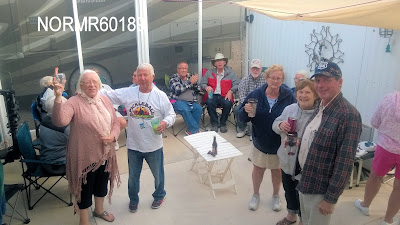We are almost "full timers" but we cheat because we have a 5th wheel in Tucson and a 30 ft. TT in Michigan. Our Roadtrek 210P is our exploration vehicle.
We left for the west in November and returned at the end of April. Our most recent trek of 5+ months has ended. Total actual miles 5,948. Planned distance 5,671. The other miles were side trips, miscellaneous excursions, maintenance (changed the engine oil in Tucson, replaced the coach batteries (at 4.5 years), etc.). We stayed at multiple locations ranging from Tucson, AZ to Fredericksburg, TX to Baton Rouge, LA and continuing to the west coast of Florida and then to the Florida Keys. Some stops were much longer than others. I prefer to spend at least two nights in each location, but we sometimes spend only one if we are going for distance.
Once we find a great locale we may stay for weeks, or months.
Some days we may only travel a couple of hundred miles. On others we may go as far as 713 miles, which was the maximum distance on one day for this trek. We simply wanted to get from point A to point B.
The trip was not without a few mishaps. No real issues with the 210P, but people sometimes break.
We are "almost" full timers; we could have delayed our "return" by three days and gone directly to our summer site in Michigan. But we didn't. Instead we went to "home base #1" No issues of any significance with our 2013 210P on this trek, but I did take the opportunity to replace the coach batteries which were nearing 5 years of age and not able to provide the desired capacity.
Current odometer mileage 25,698.
The above is a mileage history for one period for this trek. The data is from my Verizon Hum, which monitors the vehicle vitals via the OBD port as well as GPS. In general, I guess the data is accurate. I assume the high speed was achieved going downhill because I generally drive the speed limit. For much of the interstate travel that was posted at 70 MPH, but there were segments posted at 75, 80 and 85. My preference is speed limit to 5 MPH under if conditions are good. However, it seems that more than a few travellers prefer 5 to 10 MPH over the posted speed limit. Traveling on four lane interstates can get interesting (two lanes each direction). One can stay in the right lane and attempt to dodge those entering who apparently don't understand how to merge, or one can move to the second lane and be pushed down the road. However, the further west we go the easier it gets, until one hits CA that is, Then all bets are off.
Here is a longer term history summary for this trek:
We had a great time. But we did have a few advantages. For one, we have an automobile stored in AZ. That allows us to do a lot of local AZ travel without using the Roadtrek 210P, which is our major trekking vehicle.
For another, we have positioned a 5th wheel and a travel trailer at two locations which permits us to use these as "home bases" and to put our feet up in more comfort (more than the 700 cubic feet of the Roadtrek) and for longer periods of time. However, we have lived in the 210P for up to about 100 continuous days. I've made 20+ modifications to tailor it to our lifestyle.
Here's our AZ abode; 1-1/2 baths, 5 slides and more than enough room for a "home base." And it has an outdoor cookstation. However, we do take cast iron and in induction burner with us in the Roadtrek. We like to cook.
During this trek, I was able to bake my special recipe of cinnamon buns. We gave most away. I was pleased by the results of this 1/2 batch. No complaints by anyone.
There were the desert scenes, the sunrises, the sunsets and the rainbows:
We experienced wonderful Florida sunrises and sunsets, as well as low and high tides.
and Texas wildflowers as well as the desert bloom.
Ad, or course there were the people we met on our journey.
And there was the wildlife, or "not so wild" life. Some creatures large, and some small.

































